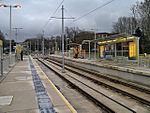Chadderton Urban District
ChaddertonDistricts of England abolished by the Local Government Act 1972Districts of England created by the Local Government Act 1894History of LancashireLocal government in the Metropolitan Borough of Oldham ... and 1 more
Urban districts of England

Chadderton Urban District was, from 1894 to 1974, a local government district of the administrative county of Lancashire, England. It was centred on the town of Chadderton. It was created an urban district in 1894 by the Local Government Act 1894 and included the civil parish of Chadderton and part of the district of Hollinwood. In 1974 Chadderton Urban District was abolished by the Local Government Act 1972 and its former area transferred to Greater Manchester to form part of the Metropolitan Borough of Oldham.
Excerpt from the Wikipedia article Chadderton Urban District (License: CC BY-SA 3.0, Authors, Images).Chadderton Urban District
Featherstall Road South,
Geographical coordinates (GPS) Address Nearby Places Show on map
Geographical coordinates (GPS)
| Latitude | Longitude |
|---|---|
| N 53.54 ° | E -2.13 ° |
Address
Featherstall Road South
OL9 6HL , Werneth
England, United Kingdom
Open on Google Maps







